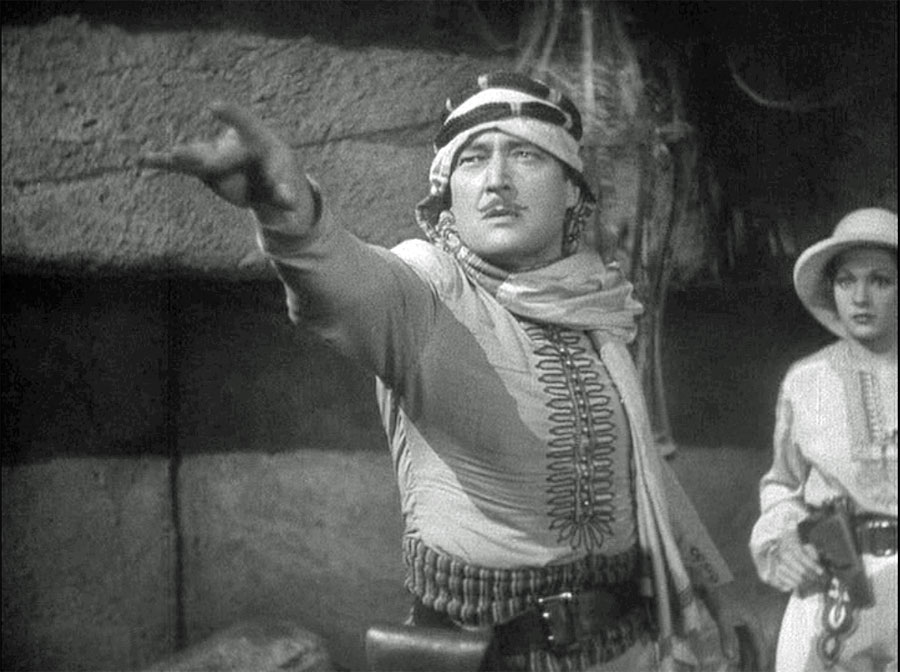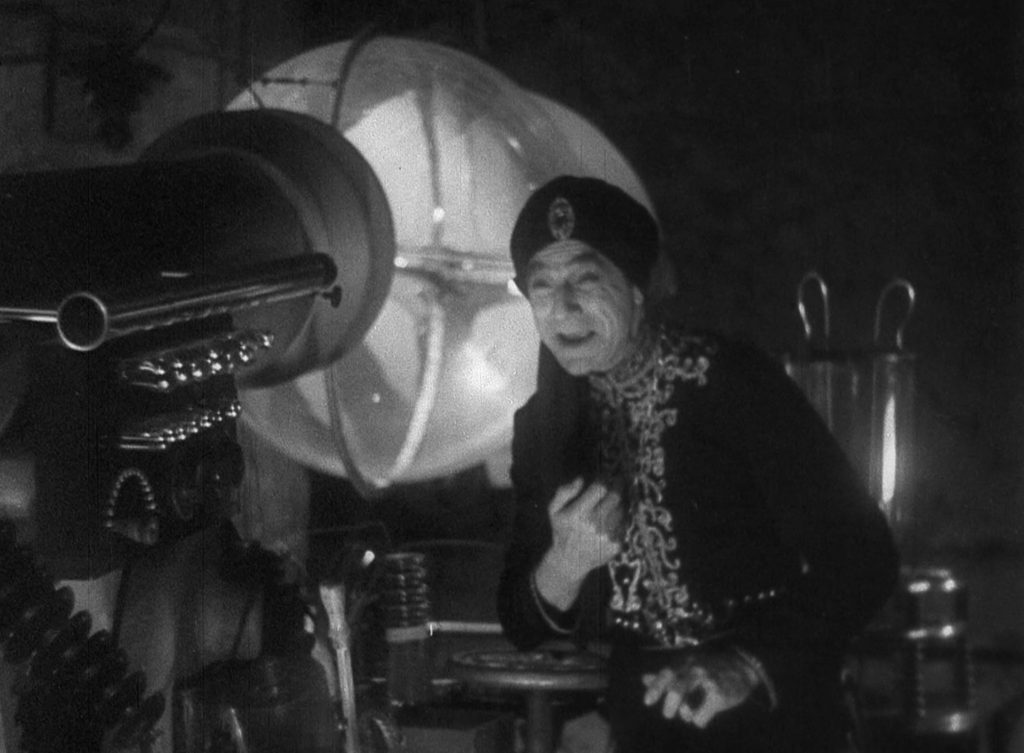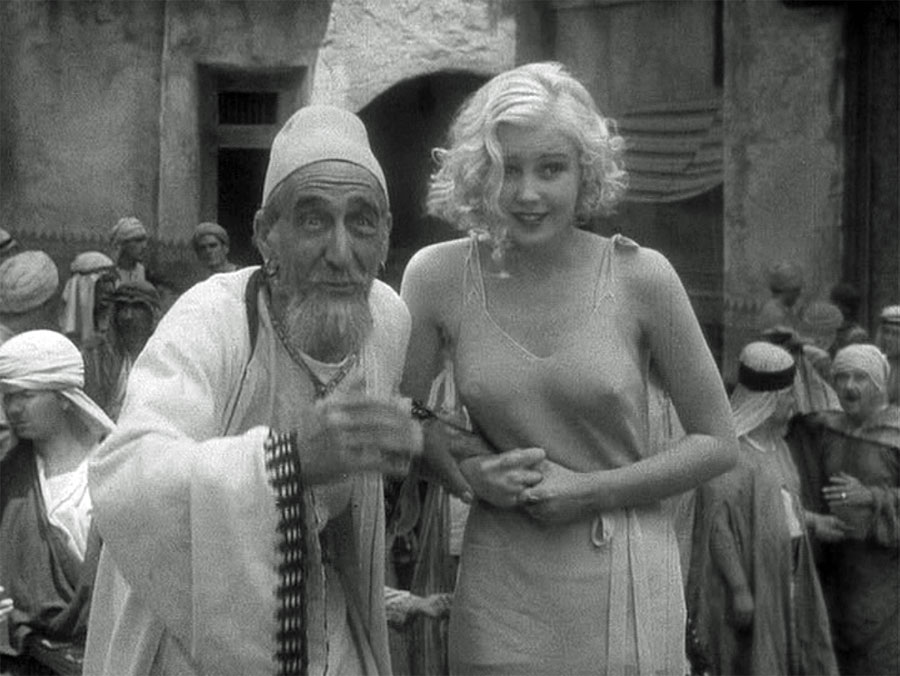Chandu Brings The Tricks, Lugosi Brings The Magic
DIRECTED BY: WILLIAM CAMERON MENZIES & MARCEL VARNEL/1932
STREET DATE: AUGUST 23, 2016/KINO LORBER
 It’s like Saturday afternoon in 71 minutes. Chandu the Magician is one of those movies where the outcome is never in question and the peril is purely cartoon, but the wonderfully un-ironic fun of it all never lets up. Heightened acting, heightened locations, heightened evil banter, the movie curls like a living rope up out of the long-running kids’ radio show of the same name, all about an American who goes into India as Frank Chandler and returns as Chandu, a sort of super-yogi who has all the powers of mind control, astral projection, teleportation, and general bonhomie at his fingertips, all of which he uses to fight the forces of evil across the globe. The film picks up as Chandu’s (Edmund Lowe) graduating with honors in the temple and barely has time to cut the cake before getting word his sister’s husband, Robert – a brilliant scientist – has been kidnapped by the evil Roxor (Bela Lugosi) who wants the secrets to Robert’s immense death ray. One of the charming quirks of the movie is asking us to root for a good guy scientist who’s also, for reasons never explained, building a giant ray gun that can demolish cities. Once Chandu is on the case, the movie settles into a series of Roxor’s roadblocks that require Chandu’s magic to escape – conniving henchmen, poisoned drinks, revolving walls, suffocating burial rooms, tear gas, a water-submerged sarcophagus. There’s not a reel in the entire movie that doesn’t have a special danger in store for our hero.
It’s like Saturday afternoon in 71 minutes. Chandu the Magician is one of those movies where the outcome is never in question and the peril is purely cartoon, but the wonderfully un-ironic fun of it all never lets up. Heightened acting, heightened locations, heightened evil banter, the movie curls like a living rope up out of the long-running kids’ radio show of the same name, all about an American who goes into India as Frank Chandler and returns as Chandu, a sort of super-yogi who has all the powers of mind control, astral projection, teleportation, and general bonhomie at his fingertips, all of which he uses to fight the forces of evil across the globe. The film picks up as Chandu’s (Edmund Lowe) graduating with honors in the temple and barely has time to cut the cake before getting word his sister’s husband, Robert – a brilliant scientist – has been kidnapped by the evil Roxor (Bela Lugosi) who wants the secrets to Robert’s immense death ray. One of the charming quirks of the movie is asking us to root for a good guy scientist who’s also, for reasons never explained, building a giant ray gun that can demolish cities. Once Chandu is on the case, the movie settles into a series of Roxor’s roadblocks that require Chandu’s magic to escape – conniving henchmen, poisoned drinks, revolving walls, suffocating burial rooms, tear gas, a water-submerged sarcophagus. There’s not a reel in the entire movie that doesn’t have a special danger in store for our hero.
 Directing duties were split between comedy man Marcel Varnel, who generally handled the character scenes (especially those concerning Chandu’s boozy right-hand man, Miggles) and the legendary production designer-turned-director, William Cameron Menzies, who was in charge of the bigger set pieces and action scenes. Menzies, who went on to production design Gone with the Wind (1939) and direct Things to Come (1936) and Invaders from Mars (1953), was already making a name for himself as an art director in films like the original The Thief of Bagdad (1924) and as director of 1931’s The Spider, always bringing to the work his extraordinary capacity for scale and imagination. His style is present everywhere in Chandu, starting with the dream-like, meant-to-be-obvious miniatures of sub-continental Hindu temples, to the massive, multi-roomed Egyptian burial palace, to Roxor’s cavernous underground lair, one that looks every bit like the Cairo branch office of Frankenstein’s laboratory. Together, the two men rode the line between crafting a new and magical world for the bigger-than-life characters, and honoring the fact that the source material was radio, meaning everyone who sank their brains into the narrative had their own images painted across their minds.
Directing duties were split between comedy man Marcel Varnel, who generally handled the character scenes (especially those concerning Chandu’s boozy right-hand man, Miggles) and the legendary production designer-turned-director, William Cameron Menzies, who was in charge of the bigger set pieces and action scenes. Menzies, who went on to production design Gone with the Wind (1939) and direct Things to Come (1936) and Invaders from Mars (1953), was already making a name for himself as an art director in films like the original The Thief of Bagdad (1924) and as director of 1931’s The Spider, always bringing to the work his extraordinary capacity for scale and imagination. His style is present everywhere in Chandu, starting with the dream-like, meant-to-be-obvious miniatures of sub-continental Hindu temples, to the massive, multi-roomed Egyptian burial palace, to Roxor’s cavernous underground lair, one that looks every bit like the Cairo branch office of Frankenstein’s laboratory. Together, the two men rode the line between crafting a new and magical world for the bigger-than-life characters, and honoring the fact that the source material was radio, meaning everyone who sank their brains into the narrative had their own images painted across their minds.
 As for the actors, unfortunately, Chandu is a much more interesting character than Lowe has the power to play. In a movie so stuffed with surreal special effects, magnificent sets, and a plot that pits the future of humanity against a city-obliterating ray gun, Lowe is definitely the low point. But Menzies and Varnel have a secret weapon of their own: Bela Lugosi. A fact proven handily in Dracula the year before, Lugosi has undeniable screen presence. He doesn’t have to do much to channel megalomaniacal menace, but he does much anyway. Lugosi has the perfect face for evil – those high-arched eyebrows, the innate smugness, the broad, expressive mouth. It’s fun watching his lips, ever in motion, dance around words like “Chan-dooo” and phrases like “I can blast them all into heaps of smoking ruins!” But mostly it’s in his squinting, gleaming eyes – his thousand-victim gaze tips you off that Lugosi might actually believe the things he’s saying, that somehow when Roxor says, “They shall bow before me in worship,” Roxor means Lugosi. He’s given himself over so much to the character that the broadness becomes perfectly plausible, and in this complete devotion to performance, Lugosi pulls the Ricardo Montalban/Khan trick, fairly well stealing the movie for the side of evil. It’s little wonder that when time came for the inevitable sequel, the producers skipped decorum and just cast Lugosi as Chandu.
As for the actors, unfortunately, Chandu is a much more interesting character than Lowe has the power to play. In a movie so stuffed with surreal special effects, magnificent sets, and a plot that pits the future of humanity against a city-obliterating ray gun, Lowe is definitely the low point. But Menzies and Varnel have a secret weapon of their own: Bela Lugosi. A fact proven handily in Dracula the year before, Lugosi has undeniable screen presence. He doesn’t have to do much to channel megalomaniacal menace, but he does much anyway. Lugosi has the perfect face for evil – those high-arched eyebrows, the innate smugness, the broad, expressive mouth. It’s fun watching his lips, ever in motion, dance around words like “Chan-dooo” and phrases like “I can blast them all into heaps of smoking ruins!” But mostly it’s in his squinting, gleaming eyes – his thousand-victim gaze tips you off that Lugosi might actually believe the things he’s saying, that somehow when Roxor says, “They shall bow before me in worship,” Roxor means Lugosi. He’s given himself over so much to the character that the broadness becomes perfectly plausible, and in this complete devotion to performance, Lugosi pulls the Ricardo Montalban/Khan trick, fairly well stealing the movie for the side of evil. It’s little wonder that when time came for the inevitable sequel, the producers skipped decorum and just cast Lugosi as Chandu.
 It’s a fair assumption that one can’t expect, in 2016, to enjoy a movie like this on its own terms. An 84-year-old movie that fed off a radio adventure catering to children in a “simpler time” is not the stuff of adult film-going entertainment today. It’s probably impossible to see certain moments here and not think of Indiana Jones, for instance, or any of the other Spielberg- and Lucas-style pastiche movies that took the elements from such innocent fare and re-conjured them into pure retro cinema, essentially rescuing the old for the consumption of a knowing audience. And yet, as so much of the extras content on the disc points out, there’s something refreshing about watching, say, Lugosi gripping the ray gun handle that would spell disaster for the world and hissing out, “This lever is my scepter…” without a trace of irony or post-modern wink. Watching Chandu now might never be like watching it in 1932, but it’s so elemental, so purely of its time, and, in this case, so well-crafted and solid, it makes the glance back toward it feel downright medicinal.
It’s a fair assumption that one can’t expect, in 2016, to enjoy a movie like this on its own terms. An 84-year-old movie that fed off a radio adventure catering to children in a “simpler time” is not the stuff of adult film-going entertainment today. It’s probably impossible to see certain moments here and not think of Indiana Jones, for instance, or any of the other Spielberg- and Lucas-style pastiche movies that took the elements from such innocent fare and re-conjured them into pure retro cinema, essentially rescuing the old for the consumption of a knowing audience. And yet, as so much of the extras content on the disc points out, there’s something refreshing about watching, say, Lugosi gripping the ray gun handle that would spell disaster for the world and hissing out, “This lever is my scepter…” without a trace of irony or post-modern wink. Watching Chandu now might never be like watching it in 1932, but it’s so elemental, so purely of its time, and, in this case, so well-crafted and solid, it makes the glance back toward it feel downright medicinal.
The images in this review are not representative of the actual Blu-ray’s image quality, and are included only to represent the film itself.

